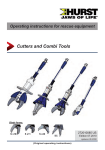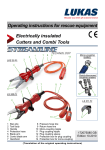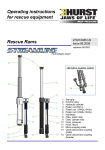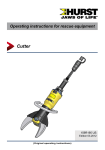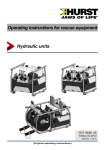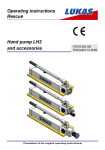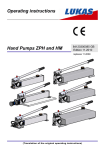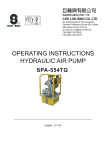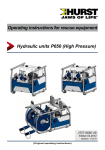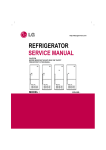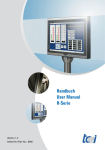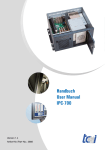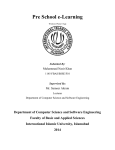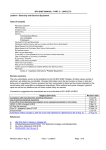Download User Manual - Hurst Jaws Of Life
Transcript
Operating instructions for rescue equipment Spreaders 271010085 US Edition 07.2010 replaces 06.2008 (Original operating instructions) Content Page 1. Hazard classes 4 2. Product safety 5 3. Proper use 8 4. Description of the functions 9 4.1 Description 9 4.2 Unit in detail 10 4.3 Circuit diagram 11 4.4 Control of the operating movements 11 4.5 Hydraulic supply 11 4.6 Hoses 11 5. Connecting the equipment 12 5.1 General information 12 5.2 Coupling the mono-couplings 12 5.3 Coupling the quick-disconnect-couplings 14 6. Operation 15 6.1 Preparatory measures 15 6.2 Operating the star grip 15 7. Spreading, pulling, peeling and squeezing 16 7.1 Safety notes 16 7.2 Spreading 16 7.3 Pulling 18 7.4 Peeling 18 7.5 Squeezing 19 8. Dismantling the equipment / deactivation following operation 20 8.1 Spreader 20 8.2 Hydraulic unit 20 8.3 Hoses 20 9. Maintenance and service 20 9.1 Spreader, overall 21 9.2 Protective equipment 21 10.Repairs 22 22 10.1 General information 10.2 Preventative service 23 10.3 Repairs 24 11. Troubleshooting 35 2 12. Technical data 37 12.1 Peeling 42 12.2 Recommended hydraulic fluid 42 12.3 Operating and storage temperature ranges 42 13. Notes 43 3 1. Hazard classes We distinguish between various categories of safety notes. The table below gives you an overview of the assignment of symbols (pictograms) and key words to the specific hazard and possible consequences. Damage / injury to device human Pictogram Key word Definition Consequences DANGER! Immediate danger Death or major injury WARNING! Potentially dangerous situation Potential death or major injury CAUTION! Less dangerous situation Minor or slight injury CAUTION! Danger of damage to device / environment Damage to the equipment, damage to the environment, damage to surrounding materials REMARK Advice for application and other important / useful information and advice No injury / damage to persons / environment / equipment - Wear helmet with face protection Wear safety gloves Wear safety shoes Proper recycling Observe principles of environmental protection Read and observe operating instructions 4 2. Product safety HURST products are developed and manufactured in order to guarantee the best performance and quality when used properly. Operator safety is the most important aspect of the product design. Moreover, the operating instructions are intended to help the safe use of HURST products. The generally applicable, legal and other binding regulations pertaining to the prevention of accidents and protection of the environment apply and are to be implemented in addition to the operating instructions. The equipment may only be operated by persons with appropriate training in the safety aspects of such equipment – otherwise, there is a danger of injury occurring. We would like to point out to all users that they should read carefully the operating instructions and the instructions contained therein before they use the equipment, and that they should carefully follow such. We further recommend that a qualified trainer train you in the use of the product. WARNING / CAUTION! The operating instructions for the hoses, the accessories and the connected hydraulic equipment must also be observed! Even if you have already received instructions on how to use the equipment, you should still read the following safety notes through again. WARNING / CAUTION! Ensure that the accessories and connected equipment used are suitable for the max. operating pressure! Please ensure that no body parts or clothing get stuck between the visibly moving parts (e.g. spreader arms). Wear protective clothing, safety helmet with visor, protective gloves It is prohibited to work under load if this load is lifted exclusively by hydraulic equipment. If this work is absolutely imperative, additional mechanical supports must be used. Inspect the equipment before and after use for visible defects or damage Inspect all cables, hoses and screwed connections for leaks and externally visible damage! If necessary, repair immediately! Squirting oil can result in injuries and fires. The responsible department is to be informed immediately of any changes (including to the operating behaviour)! If necessary, the equipment is to be deactivated immediately and secured! 5 In the event of malfunctions, immediately deactivate the equipment and secure it. The malfunction is to be repaired immediately. Do not carry out any changes (additions or conversions) to the equipment without obtaining the prior approval of HURST. Observe all safety and danger notes on the equipment and in the operating instructions. All safety and danger notes on the equipment are to be kept complete in a legible condition. Any mode of operation which impairs safety and/or stability of the equipment is forbidden! Comply with all specified dates or dates specified in the operating instructions pertaining to regular controls / inspections on the equipment. The maximum permitted operating pressure noted on the equipment must not be exceeded. Safety devices may never be deactivated! Before the equipment is switched on/started up, and during its operation, it must be ensured that nobody is endangered by the operation of the equipment. When working close to live components and cables, suitable measures must be taken to avoid current transfers or high-voltage transfers to the equipment. The build-up of static charge with the potential consequence of spark formation is to be avoided when handling the equipment. 6 Only original HURST accessories and spare parts may be used for repairs. Please ensure that, when working with this equipment or during transportation of such, you don’t get stuck in the looped hoses and trip. Please note that, when spreading, tearing or breaking can cause falling material, or sudden removal of such can cause it to suddenly catapult off: necessary precautions need to be taken. Only touch any broken-off parts wearing protective gloves, since the torn edges can be very sharp. The equipment is filled with a hydraulic fluid. These hydraulic fluids can be dangerous to health if swallowed or their vapours inhaled. Direct contact with the skin is to be avoided for the same reason. Please also note that hydraulic liquids can also have a negative effect on biological systems. When working with or storing the equipment, ensure that the function and the safety of the equipment are not impaired by the effects of stark external temperatures or that the equipment is damaged in any way. Please note that the equipment can also heat up over a long period of use. Ensure adequate lighting when you are working. Before transporting the equipment, always ensure that the accessories are positioned such that they cannot cause an accident. Always keep these operating instructions within reach where the equipment is used. Ensure the proper disposal of all removed parts, left-over oil, left-over hydraulic fluid and packaging materials! The generally applicable, legal and other binding national and international regulations pertaining to the prevention of accidents and protection of the environment apply and are to be implemented in addition to the operating instructions. W A R N I N G / C A U T I O N ! The equipment is to be used exclusively for the purpose stated in the operating instructions (see chapter “Proper Use”). Any other or further use is not considered proper use. The manufacturer / supplier is not liable for any damages resulting from improper use. The user bears sole responsibility for such. Observance of the operating instructions and compliance with the inspection and maintenance conditions are part of the proper use. Never work when you are overtired or intoxicated! 7 3. Proper use HURST spreaders are designed especially for rescue services. They are used to release persons trapped as a result of a road accident e.g. by forcing open the car doors (see below Fig. 1) or by squashing other parts of the vehicle. In other catastrophic situations they are used to lift (by spreading) or to displace objects in order to rescue buried or trapped persons, e.g. by concrete components in collapsed houses (see below Fig. 2), and to squash constructional components, e.g. pipes. In principle, objects can be pulled, spread, squashed or compressed in length. All objects to be worked on are to be secured using stable supports or substructures. When lifting loads, additional risks to the operator and/or persons not involved may be posed if the load moves in an uncontrolled manner or if the spreader slips or tips over. When applying the tool and lifting, make sure that there is no danger, if necessary by using additional supports or safety devices. fig. 1 fig. 2 HURST spreaders and combi tools can also be used under water at a depth of up to 40m (131 ft). CAUTION! In this case, you must strictly observe any leaks in order to avoid threats to the environment. CAUTION! All objects which are to be worked on are to be secured using stable supports or substructures. 8 WARNING / CAUTION! The following may not be squeezed: - live cables - hardened parts such as springs, spring steels, steering columns and rollers - explosive bodies such as airbag cartouches NEVER operate the rescue equipment at a higher operating pressure than that stated in the chapter “Technical data”. A higher setting can result in material damage and/or injuries. HURST rescue equipment may only be used in areas at risk of explosion if an explosion has been prevented by appropriate measures You must also take into account that sparks may be created, for example by spreading or squashing an object. When working in areas at risk of explosion, all applicable legal, national and international regulations, standards and safety rules for avoiding explosions must be observed without limitation! Spare parts and accessories for the rescue tool can be ordered from your authorisied HURST-dealer! 4. Description of the functions 4.1 Description The equipment is designed such that, via a hydraulically activated piston, two equal, opposite spreader arms are symmetrically opened by mechanical joints, thereby spreading objects. Closing the spreader arms is also carried out hydraulically and mechanically by reverse order of the piston. All spreaders ensure full load-holding function when disconnected from the hydraulic supply (e. g. when being unintentional decoupled; defective hose, and so on). (For reasons of safety, equipment SP 510 and SP 512 are internally safeguarded from 63 MPa = 630bar When the safeguarding valve responds a screeching noise can occur. Even if the screeching noise occurs in unloaded condition, deactivate the equipment immediately and contact your authorized dealer or HURST directly!) 9 4.2 Unit in detail 10 1 3 5 12 6 9 8 11 2 4 3 6 7 8 2 1 11 9 5 6 12 10 6 7 1 2 3 4 5 6 7 8 9 10 11 12 13 14 Quick-disconnect coupling system: 14 13 10 Star grip Control valve Spreader body Handle Hand guard Spreading arm Tip with borehole for chain set Roll pin Pressure hose Return hose Handhold Mono-coupling male Quick-disconnect coupling (male) Quick-disconnect coupling (female) 4.3 Circuit diagram To enable comprehension of the function, a simplified hydraulic cylinder of the rescue equipment (A) + hand valve (B) are depicted here. spreading A pulling / squeezing B 4.4 Control of the operating movements The spreading arms movement is controlled via the star grip of the mounted valve. (see cover, item 1 and, below, figure 3). fig. 3 star grip 4.5 Hydraulic supply A HURST motor pump or hand pump only may be used to drive the equipment. If the pump unit is a different make, you must make sure that it complies with HURST specifications, otherwise potential dangers may occur which are not the responsibility of HURST. Ensure in particular that the authorised operating pressure for HURST equipment is not exceeded. REMARK: Before you use pumps from a different manufacturer, you must contact HURST or an authorised dealer. 4.6 Hoses The pump unit and the rescue tool are connected by hoses. 11 5. Connecting the equipment 5.1 General information There are two short hoses on the side of the equipment: they are connected to the pump unit via two hoses. All hose assemblies are marked with a colour and have couplings to enable unmistakable connection. REMARK: The devices can be equipped with different coupling systems. They differ only by the article number and not by the designation. Of course the coupling systems can also be reequipped at a later time. WARNING / CAUTION! Before connecting the equipment you have to pay attention that all used components are suitable to the max operation pressure of the pump unit! In the case of doubt you have to inquire HURST directly! 5.2 Coupling the mono-couplings The equipment is connected to the hydraulic pump via mono-coupling halves (male and female). dust protection caps mono-coupling halve (male) mono-coupling halve (female) 12 Before coupling, remove dust protection caps, then connect male and female, and turn the locking sleeve of the female to direction „1“ until the locking sleeve locks into place. The connection is now in place and secure. Decoupling is by turning the locking sleeve to direction „0“. The equipment can also be coupled under pressure provided the connected equipment is not activated. REMARK: We recommend coupling the coupling halves in a pressureless state, when working in areas with low ambient temperature and the usage of extension hose assemblies / hose reels, otherwise decoupling could need very high expenditure of force. To protect them from dust, the accompanying dust protection caps must be put back on. Using the dust protection caps: The “A” dust protection caps have two internal pins “B”. The dust protection caps must be placed on the coupling pins in such a way that the pins are guided into the “C” grooves. Fasten the screw up to the limit stop to fix the dust protection caps on the coupling pins. A C B WARNING/CAUTION! The mono-couplings may not be screwed off the hose assemblies and / or the hose assemblies be confused! 13 5.3 Coupling the quick-disconnect-couplings The equipment is connected to the hydraulic pump via quick-disconnect-coupling halves (male and female). X Y Before coupling unlock the connect socket by turning the sleeve into position X. Retract sleeve and connect plug and socket. Release sleeve and turn it into position Y. Now the connection has been made and locked. Uncoupling is done in the reverse order. CAUTION! Always connect the return line first and afterwards the supply line! REMARK: Coupling of the devices is only possible, when the hoses are depressurized. To protect them from dust, the accompanying dust protection caps must be put back on. WARNING/CAUTION! The quick-disconnect-couplings partly have special functions. Therefore it is not allowed to screw them off from the hoses or to exchange them! 14 6. Operation 6.1 Preparatory measures 6.1.1Commissioning Before commissioning and following repairs, the equipment must be deaerated. - Connect the equipment to the hydraulic pump (see chapter “Connecting the equipment”). - Open / close the spreader arms of the equipment without any load at least twice (see chapter “Operation of the star grip”). REMARK: We recommend that during the deaeration, the attached aggregate for the hydraulic supply should stand on a higher level than the body of the rescue tool. Recommended procedure for the deaeration of the rescue tool: 1.) open and close fully with the spreader arms facing upwards. 2.) open and close fully with the spreader arms facing downwards. 3.) open and close fully with the spreader arms facing upwards. 4.) open and close fully with the spreader arms facing downwards. 6.1.2Inspection of the pump unit See separate operating instructions for the relevant unit (or for the hand pump). REMARK: Before each start-up of the hydraulic unit you have to make sure that the actuating valves are set to depressurized circulation. REMARK: Before coupling the quick-disconnect couplings, the actuating valves of the hydraulic unit are set to depressurized circulation. If you use mono-couplings, you can also couple when the hoses are pressurized! 6.2 Operating the star grip Opening the device ( ): Turn the star grip in a clockwise direction (in the direction of the relevant symbol) and keep in this position. Closing the device ( ): Turn the star grip in an counterclockwise direction (in the direction of the relevant symbol) and keep in this position. “Dead-man’s” function: Following release, the star grip automatically returns to the central position, guaranteeing the full load-holding. 15 7. Spreading, pulling, peeling and squeezing 7.1 Safety notes Before rescue works can commence, the position of the obstacle must be stabilised. You must ensure an adequate substructure and / or adequate support of the object. World-wide, safety guidelines pertaining to the specific country are to be observed and complied with. In the Federal Republic of Germany, regular safety inspections according to the regulations of the Gesetzliche Unfallversicherung (GUV; connoted ‘Legal accident insurance’) are mandatory. In the event of a potentially explosive situation, it is not permitted to use motor pumps (danger of the formation of sparks). In such cases, hand pumps are to be used. The following are to be worn when working with the rescue equipment: - protective clothing, - safety helmet with visor or protective goggles, - protective gloves - and, if necessary, ear protection Before activating the rescue equipment, always ensure that there is no danger to persons either involved / uninvolved in the action by the movement of the rescue equipment or by flying fragments. Further avoid unnecessary damage to property belonging to others, objects not involved by the rescue equipment / flying fragments. Reaching between the spreader arms is strictly forbidden! WARNING / CAUTION! The particular effect of the force of the rescue equipment during operation could cause pieces of the vehicle to break off or fly off, posing a danger to persons. Those not involved in the rescue operation should therefore keep at a distance appropriate to the situation. 7.2 Spreading Use the front area of the tips for increasing the gap only. Full spreading capacity can be achieved when approximately half of the grooved area of the tips is used. The greatest force is created in the rear area of the spreading range of the tip. WARNING / CAUTION! The arms – made from a light metal alloy – may not be damaged. 16 SP 310, SP 510 and SP 512: spreading SP 300: Working surface is too small, tips slip off. Only for increasing the size of a gap (not suitable for spreading) spreading Tips get a safe grip. 17 Increasing a gap Increasing a gap Work with the tips only. Do not damage the arms. 7.3 Pulling - HURST chain sets are to be used for pulling purposes. - Before the pulling process can be performed, ensure that the bolt and hook fit correctly to prevent the chain from slipping. - Only chain sets in perfect condition may be used. - The pull chains are to be inspected at least once per year by an expert. - See separate operating instructions for the relevant chain set! Mounting bore for chain set SP 310 / SP 510 SP 512 Mounting bore for chain set SP 300 7.4 Peeling With the integrated peeling zone (see figure below) in the tool tips of spreaders SP 310, SP 510 and SP 512, sheet steels can be peeled open (for maximum sheet steel thickness t, see chapter “Technical data”). Peeling zone WARNING / CAUTION! Splinters can fly uncontrollably from particularly hard materials. Keep a safe distance! 18 7.5 Squeezing Basically, squeezing may only be carried in the area of the tips, unless an additional squeezing device is used – see figures 6 and 7 below. (This additional squeezing device is only available as an accessory for the spreader SP 310). fig. 6 fig. 7 A Squeezing plates A B C Use of this squeezing device enables squeezing closer to the spreader arm pivot point, resulting in a higher squeezing force. Spreader arm Assembly: 1. Push the squeezing plate A over the spreader arm until boreholes B1 and B2 lie flush above each other. B1 B2 2. Position the spacer washer C between the two boreholes.. fig. 8 A 3. Put the screw B from the opposite side of the spreader arm through borehole B1 and spacer washer C (see figure 9). C B fig. 9 4. Screw the screw B tightly into borehole B2. A 19 8. Dismantling the equipment / deactivation following operation 8.1 Spreader Once work has been completed, the spreader arms are to be closed so that there is a tip distance of just a few mm. This relieves the hydraulic and mechanical strain on the equipment. 8.2 Hydraulic unit Upon completion of work, the unit must be deactivated. 8.3 Hoses First of all, decouple the pressure hose then the return hose as described in chapter “Connecting the equipment”. Ensure that you put the dust protection caps back on to the couplings. 9. Maintenance and service The equipment is subject to very high mechanical stresses. A visual inspection is to be carried out after every use: however, at least one visual inspection is to be carried out annually. These inspections enable the early detection of wear and tear, which means that punctual replacement of this wearing parts prevents breakages from occurring. A function test is also to be carried out every three years or should there be any doubt regarding the safety or reliability of the equipment. (Please also observe the relevant valid national and international regulations pertaining to service intervals of rescue equipment). In the Federal Republic of Germany, regular safety inspections according to the regulations of the Gesetzlichen Unfallversicherung (GUV; connoted ‘Legal accident insurance’) are mandatory. CAUTION! Clean off any dirt before controlling the equipment! WARNING / CAUTION! In order to carry out maintenance and repair works, tools appropriate for the job and personal protecting equipment are essential. 20 9.1 Spreader, overall Inspections to be carried out: Visual inspection Spreader • Opening width of the spreader arms on the tips (see chapter “Technical data”), • General tightness (leaks), • Operability of the star grip, • Existence and stability of handle, • Labels completely existent and legibly, • Covers in perfect condition, • Couplings must be easy to couple, • Dust protection caps must be available. Spreader arms • Spreader arms free of tears and without any chipped spots or deformations on the surfaces, • Bolts and retaining rings of the spreader arms must be present and in correct working order, • Grooving of the tips must be clean and squared, and not have any tears • Tips existent and locked (for SP 300) Hoses (see also operating instructions for hydraulic hoses) • Visual control for visible damage, • Control for leaks. Function test • Opening and closing function flawlessly upon activation of the star grip, • no suspicious noises. • no further movement of the spreader arms upon interruption of the valve activation during the process (“dead-man’s” function) 9.2 Protective equipment • Control of the protective equipment on / around the rescue equipment, especially the hand guard of the moveable parts (they must be free of tears!). 21 10.1 General information 10. Repairs Servicing may only be carried out by the manufacturer or personnel trained by the manufacturer and by authorised HURST dealers. Only HURST spare parts may be used to replace all components (see spare parts list) since special tools, assembly advice, safety aspects, inspections might have to complied with (see also chapter “Maintenance and Service”). During assembly, ensure the complete cleanliness of all components, since dirt can damage the rescue equipment! WARNING / CAUTION! Protective clothes must be worn when repairs are being carried out, since parts of the units can also be pressurised in an idle state. REMARK: Please always return the guarantee registration card to HALE PRODUCTS, INC. or register your tool on the HURST website. Only then are you entitled to the extended guarantee. REMARK: Before you use couplings from a different company, you must contact HURST or an authorised dealer. REMARK when using the quick-disconnect-coupling system: Overpressure protection of the rescue equipment (model with yellow coupling nipple on the return hose) If the equipment’s short hoses are not connected to a unit, temperature increases can inadvertently cause pressure to build up in the equipment. Hence, the return hose of the equipment is equipped with a safety coupling (quickdisconnect coupling male, yellow). Unwanted overpressure (approx. 1.5 Mpa) is automatically released via this nipple: hydraulic fluid leaks. Should an hydraulic fluid leak on the coupling male be more frequent, please contact your dealer or HURST itself. If couplings from a different company are used which do not have this function, the overpressure protection can react in the valve of the rescue equipment. Hydraulic fluid leaks in the area of the star grip. Following the reduction in pressure, the valve is once again tight. Should the valve leak permanently, please immediately contact your dealer or HURST itself. CAUTION! Because HURST rescue equipments are appropriate for highest achievements, only components may be exchanged, which are specified in the spare parts list of the appropriate equipment. Further components of the equipment may only be exchanged, when: - you have participated on a appropriate HURST service training. - you have the explicit permission of the HURST Service department (After inquiry, an examination for the distribution of permission is being carried out. An examination in each individual case is necessary!) 22 10.2 Preventative service 10.2.1 Care regulations The exterior of the equipment is to be cleaned from time to time in order to protect it from external corrosion. Oil is to be applied to the metallic surfaces. 10.2.2 Function and load test If there is any doubt regarding the safety or reliability of the equipment, a function and load test must also be performed. HURST offers appropriate test equipment to this end. 10.2.3 Changing the hydraulic fluid - The hydraulic fluid must be changed after the equipment has been used approx. 200 times / after three years at the latest. - It must always be changed whenever the hydraulic fluid for the accompanying pump (motor / hand pump) is changed. This is to prevent the fresh hydraulic fluid from becoming contaminated by the used fluid from the rescue equipment. Procedure: 1. Close spreader arms (until the tips are almost touching). 2. Change the hydraulic fluid of the pump. Please observe the separate operating instructions for the pump being used! 3. Screw off the return hose on the pump: - when the hose connection is directly into the pump: completely unscrew the connection nut of the connection piece of the blue return hose. - when the hose connection is via mono-coupling to the pump: remove the cover from the mono-coupling (male). completely unscrew the connection nut of the blue returnhose on the mono-coupling (male). - when the hose connection is via quick-connect-coupling to the pump: completely unscrew the connection nut on the quick-disconnect-coupling of the blue return hose. 4. Put the return hose into a separate collecting basin for the hydraulic fluid still in the equipment. 5.Slowly open the tool (the pump must be working during this time). The old hydraulic fluid from the piston space side runs via the return hose into the separate collecting basin, and is to be disposed of in the same manner as the old hydraulic fluid of the pump. 6.Switch the pump off (motor pump) / no longer activate it (e.g. hand pump). 7.Reconnect the return hose to the pump: - when the hose connection is directly into the pump: screw the connection nut of the connection piece of the blue return hose back on. (Please observe the necessary torque of MA = 40 Nm!) - when the hose connection is via mono-coupling to the pump: screw the connection nut of the blue return hose back onto the mono-coupling (male). (Please observe the necessary torque of MA = 40 Nm!) Pull back the cover on the couplings as far as the limit stop. - when the hose connection is via quick-connect-coupling to the pump: screw the connection nut back onto the quick-disconnect-coupling of the blue return hose. (Please observe the necessary torque of MA = 35 Nm!) 8.Deaerate the rescue tool as described in the chapter “Preparatory measures”. 23 10.3 Repairs 10.3.1 Chaging the tip (SP 310, SP 510 and SP 512) Procedure: 1. Use the pulling pin to remove the roll pin “A”, 2. Replace tip, CAUTION! Before assembly, apply HURST special grease to all sliding surfaces after having thoroughly cleaned them. 3. Hammer in new roll pin. CAUTION! Before assembly, apply HURST special grease to all sliding surfaces after having thoroughly cleaned them. Also observe the installation position of the adapter sleeve to ensure optimum force distribution! Installation position of the roll pin of the SP 310 and SP 510: The opening of the roll pin should face towards the A squeezing surfaces (see figure, right) Installation position of the spiral pin of the SP 512: The external start of the spiral pin should face towards the rear end of the tip (see figure, right) A The roll pin / spiral pin comes with the tip. Pressing onto the tips on the spreader arm enables the roll pins to be inserted more easily into the boreholes. REMARK: Always replace both tips. 24 10.3.2 Replacing the plug-on tips (SP 300) Procedure: 1. In order to remove the plug-on tips “G”, you need to push the buttons “J” on both sides of a spreader arm completely and simultaneously and then remove the plug-on tip from the spreader arm by pulling it forwards. 2. Place the new tips onto the arm until they automatically click in place on the spreader arm. J H H J G G NOTE: Always replace both plug-on tips. When inserting the new tips, push both buttons “J” until the tip can be slid over them. After fitting, make sure that both buttons “J” are locked on each arm (that they are back in their original position). 25 10.3.3 Changing or tightening hoses Hoses of the pressure and/or return pipe leaks or hoses are defective. Tighten the hoses on the safety valve. (Please note! Observe torque of MA = 40 Nm!) REMARK when using mono-couplings: If you want to change the hoses, you have to dismantle the mono-couplings. CAUTION (by usage of mono-coupling-system)! Take care that the port ‘T’ of the rescue tool is always connected to the port ‘T’ of the mono-coupling. CAUTION (by usage of quick-disconnect-coupling-system)! The return hose, which is screwed onto the port “T” of the rescue tool, must be equipped with a quick-disconnect-coupling (male) always. However the supplying hose line must be equipped with a quick-disconnectcoupling (female). Procedure: C B 1. Loosen the 2 B screws in the handle sleeve with quick-disconnect protective sleeves C (hexagon socket) A 2. Remove handle sleeve A and tighten screwed connection. If necessary, renew seals. F E D 3. Dismantle hose D and sealing ring E. (There is no need to carry out this point if the hoses are just being tightened). 4. Screw the hose with sealing ring back on. Please ensure that the insulating washer F is on and correctly assembled. 5. Tighten the hose connection on the safety valve. (Please note! Observe the necessary torque of MA = 40 Nm!) dismantle assemble 6. Then replace handle sleeve, protective sleeves and screws, tighten (Torque: 5Nm) and secure it with threadlocking fluid (e. g. LOCTITE 243). 26 10.3.4 Spreader arm, spreader tips, protection cover and handle replacement (SP 310, SP 510 and SP 512) Components to be replaced Required work steps Handle 1. - 3. and 7. Protective cover 1. - 4. and 7. Plug-on tips 1. - 5. and 7. Lever links 1. - 5. and 7. Spreader arms 1. - 6. and 7. Procedure: 1. Close the rescue unit until a gap of only a few mm remains between the tips. Disconnect the device from the hydraulic power supply unit and clean thoroughly. C B 2. Unscrew nuts “A”, remove washers “B” and remove fixing bolts “C”. B B D A 3. Pull the handle “D” backwards over the hose connections. F 4. In the same way, pull the protective cover “E” backwards over the hose connections. 27 E J H J F 5. Drive the pins “F” out with a drift and remove the plug-on tips “G”. Remove the locking rings “H” and remove the handlebars “J”. J G H L K L 6. The pins “L” can be removed after removing the locking rings “K”. You can now remove the spreader arms “M” and replace them. M K M 7. The work steps must be carried out in reverse order to fit the new parts. CAUTION! Don’t forget to apply HURST special grease to all sliding surfaces. NOTE: The torque required can be taken from the spare parts list of your particular unit. 28 10.3.5 Spreader arm, spreader tips, protective cover and handle replacement on the SP 300 spreader Components to be replaced Required work steps Handle 1., 2. and 8. Protective cover 1., 5. and 8. Plug-on tips 1. - 4. and 8. Lever links 1. - 4., 6. and 8. Spreader arms 1. - 6. and 8. Work steps: 1. Close the rescue unit until a gap of only a few mm remains between the tips. Disconnect it from the hydraulic power supply unit and clean thoroughly. A 2. Remove the fixing screws “A” and remove the handle “B”. B 29 C C 3. Remove the screws “C“ and “D”. D C E C 4. Remove the two two-piece locking elements “E” on the protective cover “F” and remove the two-piece protective cover by pulling it sideways. F F 30 5. In order to remove the plug-on tips “G”, you need to push the buttons “J” on both sides of a spreader arm completely and simultaneously and then remove the plug-on tip from the spreader arm to the front. H J H J G G 6. You need to remove the locking rings “K” and the lever links “L” to replace the spreader arms “H”. K L K L H L K L K K 31 7. Also remove the locking rings “M” and remove the pins “N”. You can then remove the spreader arms “H”. H M N H M 8. The work steps must be carried out in reverse order to fit the new parts. CAUTION! Don’t forget to apply HURST special grease to all sliding surfaces. NOTE: The torque required can be taken from the spare parts list of your particular unit. 32 10.3.6 Mono-couplings The mono-couplings must be replaced in the event of: - external visible damage, - the locking device not working, - hydraulic fluid continually leaking in a coupled/uncoupled state. WARNING / CAUTION! Never repair couplings: they are to be replaced by original HURST parts! During assembly, tighten the connection nut of the hose assembly with a torque of MA = 40 Nm. Procedure: 1. Remove the cover from the couplings. 2. Loosen the connection nuts of the hose assembly and remove the coupling. 3. Position the new coupling and tighten the connection nuts of the hose assemblies with a torque of MA = 40 Nm and push the cover of the couplings back on. CAUTION! Take care that the port ‘T’ of the rescue tool is always connected to the port ‘T’ of the mono-coupling. 33 10.3.7 Quick-disconnect-couplings The quick-disconnect-couplings must be replaced in the event of: - external visible damage, - the locking device not working, - hydraulic fluid continually leaking in a coupled/uncoupled state. WARNING / CAUTION! Never repair couplings: they are to be replaced by original HURST parts! During assembly, tighten the connection nut of the hose assembly with a torque of MA = 35 Nm. Procedure: 1. Loosen the connection nut of the hose assembly and remove the coupling. 2. Position the new coupling and tighten the connection nut of the hose assemblies with a torque of MA = 35 Nm. CAUTION! The return hose, which is screwed onto the port “T” of the rescue tool, must be equipped with a quick-disconnect-coupling (male) always. However the supplying hose line must be equipped with a quick-disconnectcoupling (female). 10.3.78Valve cover If the cover is deformed to such an extent that the star grip no long works correctly, the valve must be replaced in its entirety. Have repairs carried out by an authorised dealer, by personnel specially trained by HURST, or by HURST customer service only. 10.3.9 Labels All damaged and/or illegible labels (safety notices, type plate, etc.) must be renewed. Procedure: 1. Remove damaged and/or illegible labels. 2. Clean the surfaces using industrial alcohol. 3. Attach new labels. Ensure that you attach the labels in the right position. If you are no longer sure about this, then please contact your authorised HURST dealer or HURST itself. 34 11. Troubleshooting Trouble Control Spreader arms move Are the hoses slowly or jerkily when connected activated properly? Does the pump unit work? Device doesn’t Check the perform at its given hydraulic fluid level power in the supplying pump Following release, Cover damaged the star grip doesn’t or star grip hard to return to the central move? position Cause Solution Air in the hydraulic Deaerate pump system system Insufficient hydraulic fluid in the pump Top up hydraulic fluid, deaerate Damage to the torsion spring for reset Soiled valve or star grip Repair by an authorised dealer, by personnel specially trained by HURST, or by HURST itself Defective valve Other mechanical damage (e. g. star grip) Pressure too high (e.g. caused by too-high ambient temperature) Coupling defective with mono-couplingsystem: Hoses cannot be coupled with monocoupling-system: It is frequently not possible to couple hose assemblies Set hydraulic pump to pressureless circulation Coupling needs to be replaced immediately Hydraulic fluid Hydraulic fluid Control the must be replaced degree of viscosity not adapted to the application (see chapter and application situation “Recommended temperature of Hydraulic fluids”) the used hydraulic fluid Coupling defective Coupling needs to be replaced immediately with quickdisconnect-couplingsystem: Hoses cannot be coupled Is the pump working? Pressurized Relieve pump Coupling defective Coupling needs to be replaced immediately Hydraulic fluid leak on the hoses or the fixing-ins Are the hoses defective? Leak, possible damage 35 Replace hoses Trouble Damages on the surface of the hydraulic hoses Control Cause Mechanical damages or contact with aggressive agents Defective rod seal Damage to the piston Hydraulic fluid leaks on the piston rod Solution Replace hoses Repair by an authorised dealer, by personnel specially trained by HURST, or by HURST itself Secure the loads and Leak on the handhold Increase load? Load increase move them by using (e.g. something has fallen onto the other tools part to be lifted, Move the load thereby suddenly somewhere else, increasing the where the moving load) load is lighter Use supporting equipment to move the load. Does the pressure Pressure release Following the in the Rescue tool. reduction in pressure, set on the pump no further leak is comply with present. the maximum permissible Should, however, pressure on there be a further the rescue leak on the handhold, equipment? immediately deactivate the rescue equipment, and contact an authorised dealer or HURST itself. Hoses in handhold Hoses in handhold Tighten hoses. loose? not tightened Supply and return Reconnect the Check the connections of the connection of the hoses of the monocooupling (female) in mono-coupling mono-coupling (female) inverted the right way (female) Especially by usage of quick-disconnectcouplings: Leak on the handhold Is the return hose connected correctly? Return hose is not Re-connect the return coupled correctly hose and secure it. or not connected. 36 Trouble Control Cause Especially by usage check the hose connection of mono-couplings: connections of the to the couplings Leak on the handhold hoses interchanged Returnline disabled Solution reconnect the hoses to the coupling in the right way disconnect the returnline from the coupling, clean it and reconnect it. with mono-couplingsystem: Leak in the couplings Is the coupling damaged? coupling damaged Coupling must be replaced immediately with quickdisconnect-couplingsystem: Leak in the couplings Is the coupling damaged? coupling damaged Coupling must be replaced immediately Is the leak only on Safety valve the coupling male? reacted After pressure release there is no more leakage. If it isn’t possible to rectify the malfunctions, inform an authorised HURST dealer or the HURST customer service department immediately! The address for the HURST customer service department is: HURST JAWS OF LIFE HALE PRODUCTS, INC. A Unit of IDEX Corporation 711 N. Post Road Shelby, NC 28150 USA Phone: (704) 487-6961 Fax: (704) 487-7271 e-mail: [email protected] 12. Technical data Since all values are subject to tolerances, minor differences may occur between the data on your equipment and the data in the following schedules! NOTE: The following tables contain only the technical data required for standard acceptance. Additional data concerning your unit can be obtained from HURST on request. 37 type SP 300 ref. no. 211051000 271051000 min. spreading force (25mm / 0.98in. from the tips) [kN] 34 [lbf.] 7,644 max. spreading force (25mm / 0.98in. from the tips) [kN] 42 [lbf.] 9,442 spreading force HSF (according to NFPA) [kN] 40 [lbf.] 8,993 spreading force LSF (according to NFPA) [kN] 33 [lbf.] 7,419 [mm] 605 max. spreading distance [in.] 23.82 min. pulling force (on mounting borehole for chain set) [kN] 22,5 [lbf.] 5,058 max. pulling force (on mounting borehole for chain set) [kN] 28 [lbf.] 6,294 pulling distance (on mounting borehole for chain set) [mm] 495 [in.] 19.49 pulling force HPF (according to NFPA) [kN] 23 [lbf.] 5,171 pulling force LPF (according to NFPA) [kN] 19 [lbf.] 4,272 dimensions lxwxh weight incl. hydraulic fluid max. operating pressure min. needed volume of hydraulic fluid [mm] 750 x 355 x 255 [in.] 29.53 x 13.98 x 10.04 [kg] 17,1 [lbs.] 37.7 [Mpa] * 70 [psi.] 10,153 [l] ** 0,14 [gal.-US] 0.04 quick-disconnect coupling coupling system classification acc. to DIN EN 13204 * ** mono-coupling AS 34/605-17 1 MPa = 10 bar Necessary volume of hydraulic fluid in the hydraulic unit to operate the unit (differential volume on piston / rod side) 38 type SP 310 ref. no. min. spreading force (25mm / 0.98in. from the tips) 211010000 271010000 [kN] 46 [lbf.] 10,342 max. spreading force (25mm / 0.98in. from the tips) [kN] 61 [lbf.] 13,714 spreading force HSF (according to NFPA) [kN] 53 [lbf.] 11,915 [kN] 39 [lbf.] 8,768 [mm] 720 spreading force LSF (according to NFPA) max. spreading distance [in.] 28.35 min. pulling force (on mounting [kN] borehole for chain set) [lbf.] 30 6,745 max. pulling force (on mounting [kN] borehole for chain set) [lbf.] 42 9,442 pulling distance (on mounting borehole for chain set) [mm] [in.] 22.64 pulling force HPF (according to NFPA) [kN] 30,5 [lbf.] 6,857 pulling force LPF (according to NFPA) [kN] 23 [lbf.] 5,171 dimensions lxwxh [mm] weight incl. hydraulic fluid max. operating pressure min. needed volume of hydraulic fluid 575 790 x 350 x 190 [in.] 31.10 x 13.78 x 7.48 [kg] 20,1 [lbs.] 44.3 [Mpa] * 70 [psi.] 10,153 [l] ** 0,24 [gal.-US] 0.07 quick-disconnectcoupling coupling system classification acc. to DIN EN 13204 * ** mono-coupling AS 46/720-20 1 MPa = 10 bar Necessary volume of hydraulic fluid in the hydraulic unit to operate the unit (differential volume on piston / rod side) 39 type SP 510 ref. no. 211030000 271030000 min. spreading force (25mm / 0.98in. from the tips) [kN] 62 [lbf.] 13,938 max. spreading force (25mm / 0.98in. from the tips) [kN] 92 [lbf.] 20,683 spreading force HSF (according to NFPA) [kN] 79,9 [lbf.] 17,963 spreading force LSF (according to NFPA) [kN] 54,6 [lbf.] 12,275 [mm] 800 max. spreading distance [in.] 31.50 min. pulling force (on mounting [kN] borehole for chain set) [lbf.] 38 8,543 max. pulling force (on mounting [kN] borehole for chain set) [lbf.] 55 12,365 pulling distance (on mounting borehole for chain set) [mm] [in.] 26.18 pulling force HPF (according to NFPA) [kN] 44,4 [lbf.] 9,982 pulling force LPF (according to NFPA) [kN] 31,1 [lbf.] 6,992 dimensions lxwxh [mm] weight incl. hydraulic fluid max. operating pressure min. needed volume of hydraulic fluid 665 900 x 380 x 215 [in.] 35.43 x 14.96 x 8.46 [kg] 25,5 [lbs.] 56.2 [Mpa] * 70 [psi.] 10,153 [l] ** 0,43 [gal.-US] 0.12 quick-disconnectcoupling coupling system classification acc. to DIN EN 13204 * ** mono-coupling BS 62/800-25 1 MPa = 10 bar Necessary volume of hydraulic fluid in the hydraulic unit to operate the unit (differential volume on piston / rod side) 40 type SP 512 ref. no. 211040000 271040000 min. spreading force (25mm / 0.98in. from the tips) [kN] 84 [lbf.] 18,885 max. spreading force (25mm / 0.98in. from the tips) [kN] 120 [lbf.] 26,978 spreading force HSF (according to NFPA) [kN] 108 [lbf.] 24,278 spreading force LSF (according to NFPA) [kN] 77 [lbf.] 17,311 [mm] 610 max. spreading distance [in.] 24.02 min. pulling force (on mounting [kN] borehole for chain set) [lbf.] 66 14,838 max. pulling force (on mounting [kN] borehole for chain set) [lbf.] 99 22,257 pulling distance (on mounting borehole for chain set) [mm] [in.] 17.20 pulling force HPF (according to NFPA) [kN] 67 [lbf.] 15,063 pulling force LPF (according to NFPA) [kN] 49 [lbf.] 11,017 dimensions lxwxh [mm] weight incl. hydraulic fluid max. operating pressure min. needed volume of hydraulic fluid 437 795 x 380 x 216 [in.] 31.30 x 14.96 x 8.50 [kg] 26,4 [lbs.] 58.2 [Mpa] * 70 [psi.] 10,153 [l] ** 0,34 [gal.-US] 0.09 quick-disconnectcoupling coupling system classification acc. to DIN EN 13204 * ** mono-coupling CS 84/610-26 1 MPa = 10 bar Necessary volume of hydraulic fluid in the hydraulic unit to operate the unit (differential volume on piston / rod side) 41 12.1 Peeling Type SP 310 [mm] SP 510 SP 512 4 5 5 0.16 0.20 0.20 max. sheet steel thickness “t” [in.] max. possible peeling length [mm] 520 650 500 [in..] 20.47 25.59 19.69 12.2 Recommended hydraulic fluid Hydraulic fluid for HURST hydraulic equipment: Mineral oil DIN ISO 6743-4 and others Oil temperature range A -20 .... +55°C -4.0 .... +131°F Oil code Viscosity rating HM 10 VG 10 recommended viscosity range: 10...200 mm²/s Supplied with HM 10 DIN ISO 6743-4. Remarks (10…200 cSt.) CAUTION! Before using hydraulic fluids, which do not correspond to the above-mentioned specifications and/or are not purchased from HURST, you have to contact HURST itself! 12.3 Operating and storage temperature ranges Operating temperature Ambient temperature (device in operation) Storage temperature (device not in operation) [°C] / [°F] -20 … +55 -4 … +131 [°C] / [°F] -25 … +45 -13 … +113 [°C] / [°F] -30 … +60 -22 … +140 42 13. Notes 43 Please dispose all packaging materials and dismantled parts properly HURST JAWS OF LIFE HALE PRODUCTS, INC. A Unit of IDEX Corporation Phone: (704) 487-6961 Fax: (704) 487-7271 e-mail: [email protected] Made in GERMANY Spreader_BA_US_271010085_0710.indd © Copyright 2010 HALE PRODUCTS, INC. subject to revision 711 N. Post Road Shelby, NC 28150 USA












































